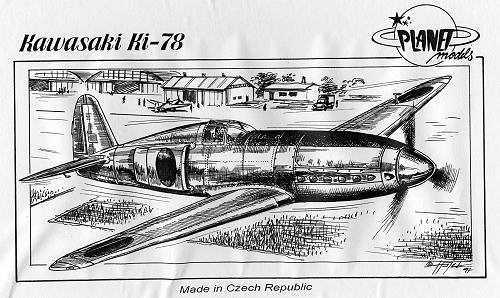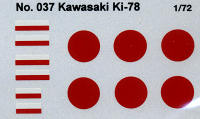
Planet Models 1/72 Kawasaki Ki-78
| KIT #: | 047 |
| PRICE: | $48.00 MSRP |
| DECALS: | One option |
| REVIEWER: | Scott Van Aken |
| NOTES: | Resin with vacuformed canopy |

| HISTORY |
The new plane featured a well-streamlined fuselage fitted with a licence-build German Daimler-Benz DB 601A engine. For extra power, methanol/water injection was used. All-metal construction was used in combination with a small and thin wing with a laminar flow profile with a knife-sharp leading edge. With its very small wing area of only 11 m2, new lift devices were used that were never used before on Japanese planes. To reduce the landing speed, a combination of Fowler and split flaps were used. To give the Daimler-Benz engine sufficient cooling, two shallow cooling ducts were fitted on each side of the rear fuselage. To give the cooling air a good airflow, a ram-air feeding system was developed using a cooling fan driven by a 60 hp engine.
By the outbreak of the war, the whole project was taken over by the Imperial Japanese Army, who gave it the military type designation Ki-78. The full-size mock-up of the Ki-78 was completed in May 1941.Under supervision of Isamu Imashi Kawasaki received the order to build two prototypes of the Ki-78. Construction was started in September 1941. The first was completed in the Gifu factory more than a year later. It was flown for the first time on 26 December 1942. At the low end of the flight envelope, the Ki-78 was found to have very tricky stall characteristics. Further it was found to be difficult to fly. Take-off speed was an incredible 205 km/h, while the landing speed was 170 km/h in spite of the use of the high-lift devices. At high speed, flutter of the elevon was encountered above 600 km/h. This was more or less cured by fitting a horn-balance. In April 1943 full-speed flight performance testing could be started, however with disappointing results. Instead of an expected maximum speed of 850 km/h, highest speed measured was 700 km/h at 3527 m at its 31st flight on 27 December 1943. The flight performance program was terminated in December 1943.
A feasibility study to improve the KI-78 flight performances showed that extensive airframe modifications were needed and as a consequence the project was officially terminated after the 32nd flight on 11 January 1944.
The second Ki-78 was never built.| THE KIT |
 Like
many of Planet Models' kits, this one is not horribly complex. It is all
packaged into a compartmentalized poly bag. This keeps the bits from bashing
into each other and also helps to keep the decals fresh. As an earlier kit,
you'll find many of the smaller parts like gear doors, landing gear, control
stick, side scoop intakes and exhaust sections and wheels on a resin wafer. The
prop was in there too, but broke away during shipment. A second set of wheels is
included so apparently there was some difficulty with those in the wafer.
Like
many of Planet Models' kits, this one is not horribly complex. It is all
packaged into a compartmentalized poly bag. This keeps the bits from bashing
into each other and also helps to keep the decals fresh. As an earlier kit,
you'll find many of the smaller parts like gear doors, landing gear, control
stick, side scoop intakes and exhaust sections and wheels on a resin wafer. The
prop was in there too, but broke away during shipment. A second set of wheels is
included so apparently there was some difficulty with those in the wafer.
The fuselage halves are joined by a rather large pour stub at
the tail of each half. One has to take care not to break this off or a chunk of
tail will come with it. The one-piece wings eliminate any problems with dihedral
or warping that you can get with thinner upper and lower wing halves in resin.
The kit comes with two nicely done vacuformed canopies. I'm pleased to see two
of them as some kits only provide one and you are doomed if you mess it up.

Instructions are a single folded sheet with a history and painting guide on one side and two exploded views on the other. Decals consist of insignia and test rectangles. The aircraft can be done either in unpainted metal or orange. Actually, no actual color information for the orange or the black anti-glare panel is provided, only the cryptic A-10 and A-24 (which means nothing to me). Decals are very nicely done and appear to be quite thin.
| CONCLUSIONS |
This was a high speed research plane so fit the largest engine it could into a small airframe. Not as tiny as the Bf-209v1, but still quite small. It is about the size of a 109 with shorter wings. It is a bit over 4" in length with a 4.5" wingspan. For those of us who like things that are not the norm, this is a fine kit and will definitely make into an equally nice model when done. For those wanting to get some experience in full resin kits, this would be a very good one.
| REFERENCES |
Japanese aircraft of the Pacific War,
by Reneé Francillon, Putnam, 2nd Edition, 1979
February 2010 This was on deep discount at
www.spruebrothers.com Thanks to If you would like your product reviewed fairly and quickly, please
contact
me or see other details in the
Note to
Contributors.